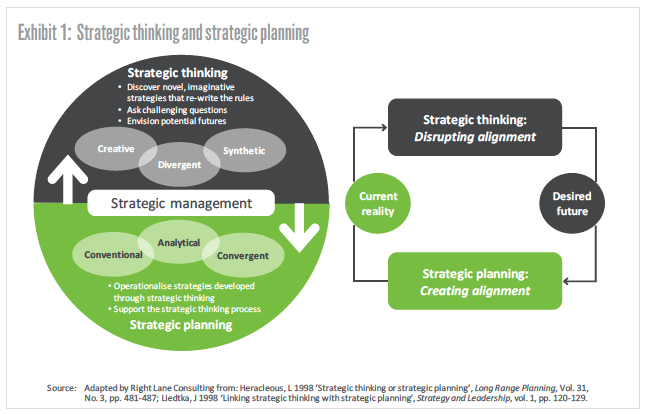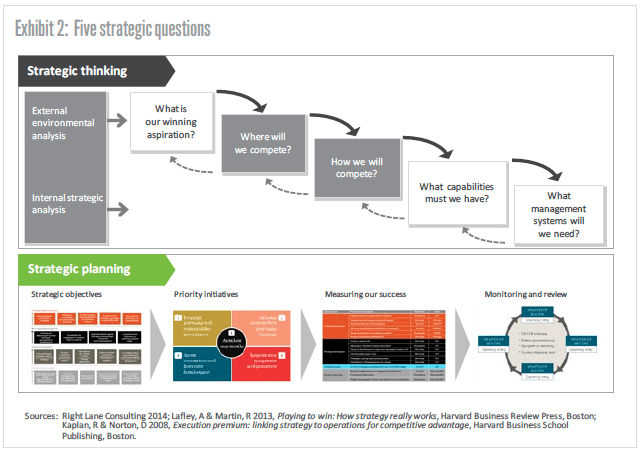Strategic thinking before strategic planning – know where to start and where to finish
By Dr Marc Levy
Hold challenging strategic conversations with your board and executive team
To avoid bias ridden planning processes, leadership teams should embrace divergent ‘strategic thinking’ as an essential component of the strategy and planning process. Strategic thinking should be challenging and can sometimes feel uncomfortable. Pushing through this ‘pain’ leads to far superior outcomes when developing strategic plans.
Right Thinking
A strategy without a plan is too conceptual. A plan without a strategy is hollow. What is your strategy and what does it mean for what you are actually going to do?
Timeless strategic questions (strategic thinking), which resonate with our clients, must be satisfactorily answered ‘upstairs’ before clients move ‘downstairs’ to strategic planning. Strategic plans should comprise strategic objectives and attendant measures, priority initiatives and a measurement monitoring and review cycle.

Helping clients with their strategy and planning processes is a major part of our practice.
This year our firm will help nearly 50 organisations with their annual strategy and planning cycles – conducting analysis, taking executive teams and boards offsite, documenting strategic plans, and assisting them with implementation, measurement, monitoring and review. I’ve personally helped more than 100 organisations with their strategy and planning work over 20 years.
In this work we are frequently asked about the interplay between strategy and strategic planning. Are they the same thing or not? There is a rich body of literature on this topic, typically lauding adaptive strategy development and lampooning rigid strategic planning.
We have a different view about the value of planning, and the confluence and complementarity of the two disciplines. A strategy without a plan is too conceptual. What does the strategy mean for what you are actually going to do? It is certainly possible to draft a strategic plan having paid little or no consideration to central strategic questions like where are you going to compete and how are you going to win. However, a plan without a strategy is hollow.
Our work in this area is inspired by leading international strategy academics and practitioners, like Jeanne Liedtka (1998), Ken Favaro (2013), Roger Martin (Lafley & Martin 2013) and Robert Kaplan and David Norton (2008).
Exhibit 1 makes the distinction between strategic thinking and strategic planning. As it shows, the former tends to be more divergent, creative and synthetic and the latter more analytical, convergent; the former can disrupt an organisation’s agenda the latter align it.

We centre our strategy work with clients on a handful of strategic questions. We’ve written about strategic questions before (refer Right Lane Review June 2014). As shown in exhibit 2 we sometimes employ Roger Martin’s five strategic questions (2012) to focus clients’ strategy development efforts.

These timeless strategic questions, which resonate with our clients, must be satisfactorily answered ‘upstairs’ before clients move ‘downstairs’ to strategic planning, the elements of which are perhaps best reflected in the work of the creators of the balanced scorecard, Robert Kaplan and David Norton (1998). Their work suggests that strategic plans should comprise strategic objectives and attendant measures, priority initiatives and a measurement monitoring and review cycle.
The strategy development should precede the planning; because, for example, you can’t make a good fist of initiative prioritisation and resource allocation unless you’ve ‘been granular’ about where to compete (Bradley et al 2011). Equally, there’s not much point creating a galvanising aspiration if you can’t action it.
We frequently tell the story of a healthcare client who identified seven distinct customer cohorts as equally important. This was not a recipe for focus and the client needed to think through prioritisation of these customers, before it could start on objective setting.
We are not the first to make this observation about the distinction between strategy and planning. Ken Favaro (2013) makes a similar point in his work on the ‘strategic five’ and the ‘corporate five’. However, much of the literature unhelpfully sets strategy and planning up as a trade off or dichotomy. We believe that they are necessarily complementary and entwined.
References
Bradley, C, Hirt, M & Smit, S 2011, ‘Have you tested your strategy lately?’, McKinsey Quarterly, January
Favaro, K 2013, ‘How leaders mistake execution for strategy (and why that damages both)’, Strategy + Business, February
Heracleous, L 1998 ‘Strategic thinking or strategic planning’, Long Range Planning, Vol. 31, No. 3, pp. 481-487
Kaplan, R & Norton, D 2008, Execution Premium: Linking strategy to operations for competitive advantage, Harvard Business School Publishing, Boston
Lafley, A & Martin, R 2013, Playing to win: How strategy really works, Harvard Business Review Press, Boston
Liedtka, J 1998 ‘Linking strategic thinking with strategic planning’, Strategy and Leadership, vol. 1, pp. 120-129.
(c) 2016 Right Lane Consulting
We hope the ideas presented here have given you something new to think about. We would love the opportunity to discuss them with you in more detail. Get in touch today.
